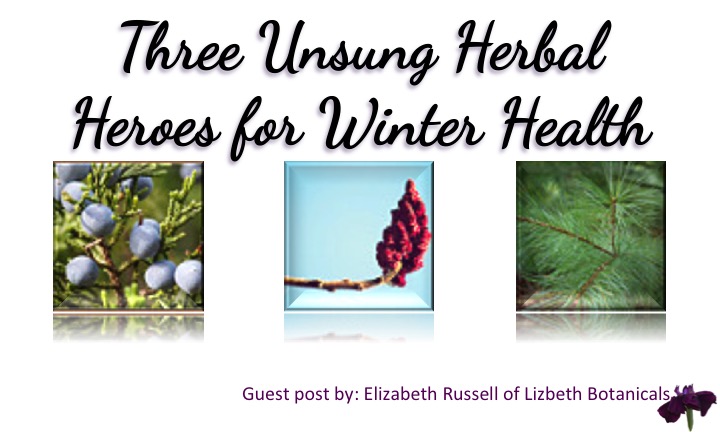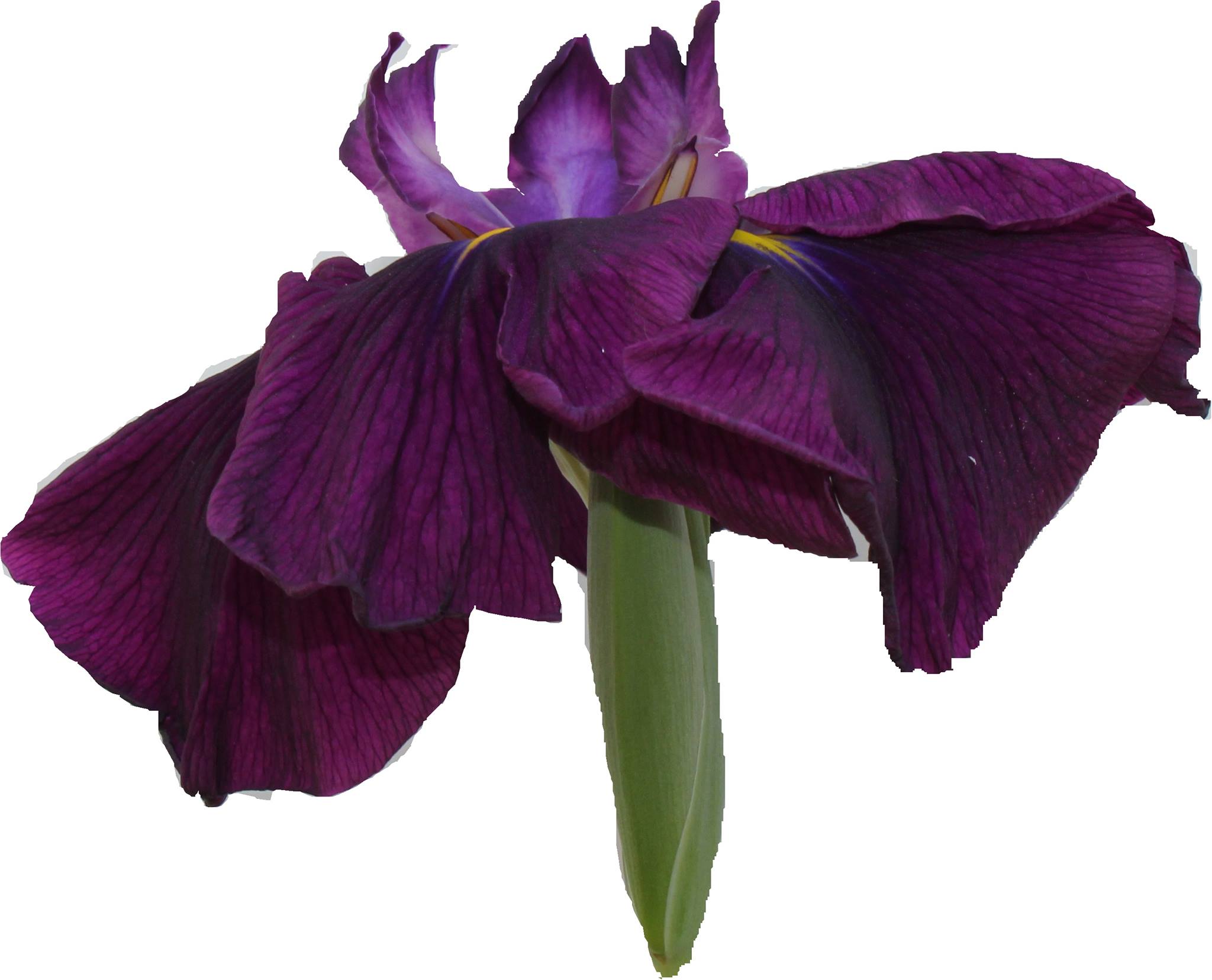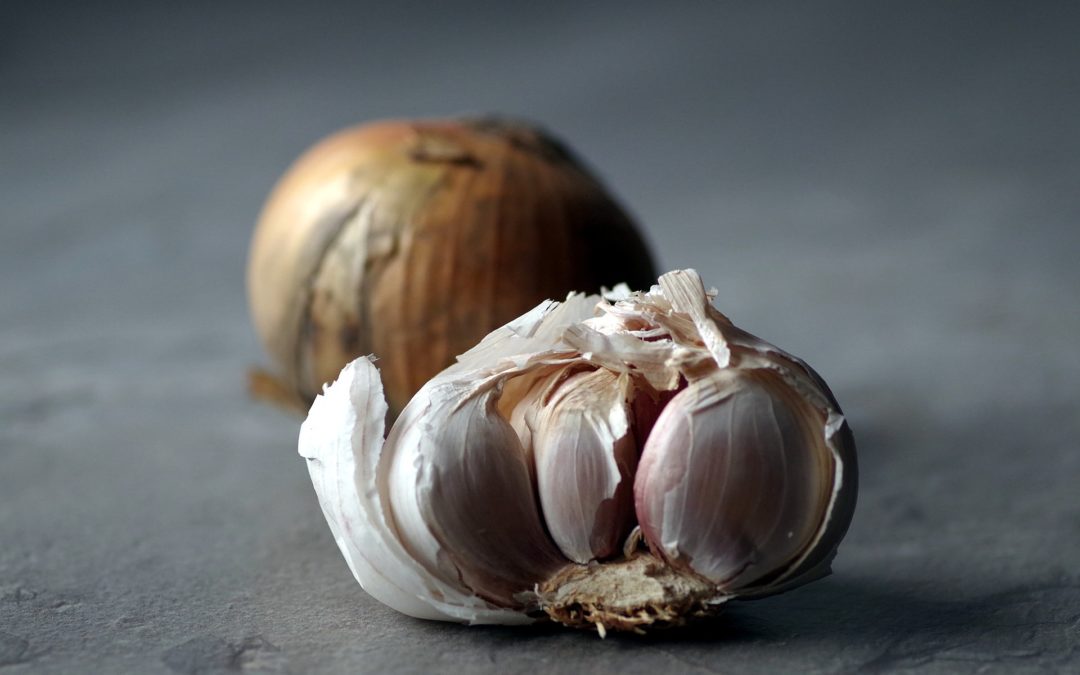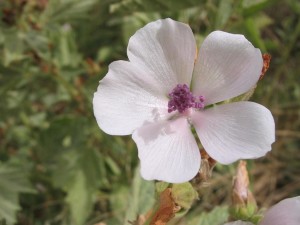
by Leslie Moldenauer | | Herbs
Guest blog by: Elizabeth Russell M. Ed, HHP, NPM, HRM of Lizbeth Botanicals
Staying healthy in the winter can often seem like a challenge. We are under a constant barrage of cold and flu viruses, temperature extremes, and even poor holiday eating habits, which can lower our resistance and lead to uncomfortable symptoms.
Remember, it is recommended that you consult with your primary healthcare professional, rather than self-diagnosing, because sometimes we need that medical expertise. From there, however, you can choose to use herbs to help maintain your winter health.
A few well-known popular herbs for winter health include echinacea Echinacea officinalis and elderberry Sambucus nigra for boosting the immune system, peppermint Mentha piperita and spearmint Mentha spicata are great for stomach upsets, and nettles Urtica dioica for allergies.
However, there are many other useful herbs, some of them easily obtainable from your own backyard or nearby field. Here is a quick view of some often “unsung herbal heroes”:
Juniper berry Juniperus communis
Juniper berry Juniperus communis is a small, bluish berry that grows on the evergreen juniper bush. The berries can be harvested and are generally dried before use. This bush is often used in landscaping, so be careful when harvesting to make sure no pesticides have been used.
These berries can be dried and used as a pepper substitute or roasted and used as a coffee substitute. Adding a few berries to wintertime dishes gives a lovely seasonal flavor. In case the flavor seems familiar, Juniper is often used as a base for gin or other liquors.

Juniper berries contain useful substances such as vitamin C, tannic acid, volatile oil and resin. Juniper berry may be helpful for inflammatory conditions, and reducing infection (both bacterial and viral). This small, yet tasty, berry is considered antiseptic, anti-viral, diuretic, and stomachic, which makes it helpful with infection, fluid retention and stomach issues. A positive aspect of juniper’s diuretic action is that it does not decrease the electrolyte levels in the body, even while increasing fluid output.
Cautions state to avoid using for too long, or with blood pressure, blood sugar or kidney issues, as it can make problems worse. It should not be used with seizure disorders. As an emmenagogue, it works on female reproductive organs, so use during pregnancy and nursing is not recommended, in amounts greater than what is found in food.
Sumac Rhus typhina
Sumac Rhus typhina, also known as Staghorn sumac, is one of the best wild antioxidants. It is considered by Native Americans to be a sacred and healing tree. The seeds, bark, and roots can all be eaten, although it’s the seeds that are most beneficial during the winter with their high vitamin C content.
The bark and roots are astringent, diuretic, tonic and refrigerant, making it good for getting rid of excess fluid, toning the body systems, and combating fever. This wonderful plant promotes healing, both internally and externally. Gathered in the spring, young shoots can be eaten or dried. Roots and fruit (berries) are gathered in the fall and can be dried. The berries can also be used fresh, to make a lemonade-type beverage, hot “tea” or even a jelly that is high in vitamin C.

Like juniper berry, sumac is also an emmenagogue herb, so use during pregnancy and nursing should be avoided. In addition, sumac can have an effect on blood sugar levels, so caution is indicated with consuming large quantities.
White pine Pinus strobus
White pine Pinus strobus, is another wild plant that is known for its high levels of vitamin C, and has a great many benefits, among which are its demulcent, expectorant and antiseptic actions. These make it very helpful with respiratory complaints such as coughs and bronchitis, as it will help soothe membranes, release phlegm and kill infection. A steam inhalation is one of the best methods used with the upper respiratory tract.
The antiseptic action of the sap (or a pine salve) is helpful with many skin issues, including cuts, scrapes, and burns. As a tea, pine can be beneficial for problems with the kidneys and bladder, due to its diuretic action.

Food options for white pine include making a tea from the fresh needles and a type of “gum” from the sap. The seeds can be used as a flavoring for cooked foods, and young shoots can be used to make a type of candy.
Staying healthy in the winter months doesn’t have to be boring or taste bad. And it doesn’t have to be limited to teas, syrups and lozenges, either! Being able to diversify the herbs we use helps keep us healthier by not overusing the same ones. Being able to harvest from your own backyard is also a bonus.
Stay healthy and herb wisely!
Elizabeth Russell, M. Ed, HHP, NPM, HRM is an Intuitive Wellness Coach, Herbalist, Reiki Master, Meditation Instructor, and Artist. She graduated with Honors from the American College of Healthcare Sciences with certifications in Holistic Health Practice, Natural products Manufacturing, and Herbal Retail Management. She is founder and owner of Lizbeth’s Botanicals an all-natural bodycare product line.
You can find her on Etsy, Instagram and Facebook at Lizbeth’s Botanicals.
www.lizbethsbotanicals.etsy.com
www.facebook.com/LizbethsBotanicals
www.instagram.com/lizbethsbotanicals
Please note that I am not a medical practitioner. The content of this website is provided for general informational purposes only and is not intended as, nor should it be considered a substitute for, professional medical advice. Do not use the information on this website for diagnosing or treating any medical or health condition. If you have or suspect you have a medical problem, promptly contact your professional healthcare provider. By using this website, you assume full responsibility and liability for your own actions.
Reference List
A modern herbal | Juniper berries. (n.d.). Retrieved 24 November 2015, from https://www.botanical.com/botanical/mgmh/j/junipe11.html
A modern herbal | pine, white. (n.d.). Retrieved 24 November 2015, from https://www.botanical.com/botanical/mgmh/p/pinewh36.html
Jackson, D., & Bergeron, K. (2000). Wild Sumach herbal and edible use. Retrieved 24 November 2015, from http://altnature.com/gallery/sumach.htm
Juniper benefits & information. (n.d.). Retrieved 24 November 2015, from http://www.herbwisdom.com/herb-juniper.html
Juniper berries: Benefits: Detoxification benefits. (n.d.). Retrieved 24 November 2015, from http://www.anniesremedy.com/herb_detail30.php
Pinus strobus white pine, eastern white pine PFAF plant database. (n.d.). Retrieved 24 November 2015, from http://www.pfaf.org/user/Plant.aspx?LatinName=Pinus+strobus
Vertolli, M. (2015). Staghorn sumac. Retrieved 24 November 2015, from http://www.vitalitymagazine.com/article/staghorn-sumac/#sthash.zyE5mZxP.dpuf
Weed, S. (2007). Pine keeps you fine – Susun weed herbal medicine articles on women’s health: Menopause, fertility, breast cancer / breast health, and much more.. Retrieved 24 November 2015, from http://www.susunweed.com/Article_Pine-Keeps-You-Fine.htm
Resources (weblinks):
http://altnature.com/gallery/sumach.htm
http://www.anniesremedy.com/herb_detail30.php
https://www.botanical.com/botanical/mgmh/j/junipe11.html
https://www.botanical.com/botanical/mgmh/p/pinewh36.html
http://www.herbwisdom.com/herb-juniper.html
http://www.pfaf.org/user/Plant.aspx?LatinName=Pinus+strobus
http://www.susunweed.com/Article_Pine-Keeps-You-Fine.htm
http://www.vitalitymagazine.com/article/staghorn-sumac/#sthash.zyE5mZxP.dpuf
Photo Credits
Juniper berry photo credit:http://www.flickr.com/photos/53197974@N05/11333256495
Sumac photo credit: http://www.flickr.com/photos/66762373@N04/22597699277
White Pine Photo Credit: http://www.flickr.com/photos/50697352@N00/8012971212

by Leslie Moldenauer | | Herbs, Vitamins
Moms, we are always looking for ways to keep both ourselves and our kids healthy, right? The lists of helpful things available to us are long, and today I want to talk about a few natural ways to boost your immune system. (There are many ways, I will cover my top 10) I am sure we can all agree that there is no good time to get sick. Luckily, there are many things at our disposal that can go a long way to keep our immune system strong and doing its best to kill what we come in contact with on a day to day basis.
#1 Vitamin D-The sun is our friend. Research suggests three-quarters of U.S. teens and adults are deficient in vitamin D… leaving them with less-than-optimal health (1).
Your skin naturally produces your body’s supply of vitamin D from direct exposure to bright midday sun with a mere ten or fifteen minutes’ exposure per day. What is one of the symptoms of low Vitamin D? You guessed it….a greater incidence of cold and flu. Taking a low amount of Vitamin D is perfectly safe if you are not able to get this amount of sunshine a day. It is said that fair skinned individuals, especially redheads, can absorb and utilize Vitamin D much easier than others. Where you live also plays an important part. The closer to the equator you live, the better. Since Vitamin D is is NOT a water soluble vitamin, please be sure to get your Vitamin D levels checked by your doctor before taking large amounts via a supplement.
#2 Eat a healthy diet-It goes without saying that eating healthy will boost your immune system. Eat plenty of vegetables, fruits, nuts, and seeds which will provide your body with the nutrients your immune system needs. Simply put, illness and dis “ease” thrives on sugar. Consuming too much sugar suppresses the immune system cells responsible for attacking bacteria.
#3 Probiotics– Probiotics are a form of healthy gut bacteria. Their job it to stimulate naturally forming enzymes in the gut to keep out digestive system happy and healthy, and to keep us well. Keep your gut flora in check and in good balance by consuming plenty of fermented foods or by taking a quality daily supplement.
#4 Echinacea– Echinacea stimulates the body to produce more infection-fighting white blood cells, such as T-lymphocytes and killer white blood cells. Echinacea also seems to search out and destroy some viruses, such as the common cold and flu viruses. There have been many studies performed on echinacea with mixed results. Some say that echinacea should be used periodically as a preventative, others say use echinacea when you get sick. Do some research for yourself!
*Echinacea is NOT for you if you have an autoimmune condition such as lupus, rheumatoid arthritis, or diabetes. I recommend taking it for no more than 2-4 weeks, respectively, without taking a break.
Read more on echinacea here.
#5 Ginger-One of my FAVORITE herbs. (Technically a root) Ayurvedic medicine believes that ginger helps to cleanse the lymphatic system, which is our body’s sewage system (2). By helping keep your airways and lymphatics open, ginger may help prevent the accumulation of the toxins that may increase your risk of infection. (It may help with aches and pains too!)

*There are contraindications to using ginger. Do not take ginger if you use anticoagulants, have gallstones, or a clotting disorder (3).
#6 Garlic-Cook with it often, raw is best (although you might not be holding many conversations afterwards) Allicin, the primary active constituent of garlic has been used to prevent colds and flu. There is truth to grandma’s chicken soup! Garlic is also a natural antibiotic, and can help fight off infection before it sets in (4). Crush the garlic bulb on the counter and let sit for 10 minutes before adding it you your meals (or eating raw) to release this potent compound. If using in cooking add at the later part of the cooking process to retain this powerful constituent.
*Do not use is you take anticoagulants of have liver problems. Garlic can cause gastrointestinal discomfort in some people or in excess.
#7 Elderberry Syrup– Used for its antioxidant activity, boosting the immune system, and is great for coughs, colds, and flu, elderberry syrup is a must have in your home. There is research to back up this powerful little berry, here is one study on PubMed. Elderberries contain amino acids, carotenoids, flavonoids, vitamins A and B and a large amount of vitamin C. They are also mildly laxative, a diuretic, and diaphoretic. Flavonoids, including quercetin, are believed to account for the therapeutic actions of the elderberry flowers and berries.
Here are some additional studies that speak to the benefits of elderberry. You can purchase at your local CVS, Walgreens, or buy on Amazon. I prefer to make my own.
*Kong F. Pilot clinical study on a proprietary elderberry extract: efficacy in addressing influenza symptoms. Online Journal of Pharmacology and Pharmacokinetics. 2009;5:32-43.
*Roschek B, Fink RC, McMichael MD, et al. Elderberry flavonoids bind to and prevent H1N1 infection in vitro. Phytochemistry. 2009;70:1255-61.
*Ulbricht C, Basch E, Cheung L, et al. An evidence-based systematic review of elderberry and elderflower(Sambucus nigra) by the Natural Standard Research Collaboration. J Diet Suppl. 2014;11(1):80-120.
*Zakay-Rones Z, Thom E, Wollan T, Wadstein J. Randomized study of the efficacy and safety of oral elderberry extract in the treatment of influenza A and B virus infections. J Int Med Res. 2004;32:132-40.
#8 Sleep-Something that even I struggle with. Not due to insomnia, (I consider myself very lucky) but due to being a Mom of two small children and a full time student. I often burn the candle at both ends. I do my best to get minimum of 7 hours of sleep, 7-9 is ideal. Fatigue increases your susceptibility to illness. Like stress, insomnia can cause a rise in inflammation – and similarly an increase in cortisol-your stress hormone. The higher your stress, the weaker your immune system gets.
#9–Yoga, meditation, and other relaxation techniques– If stress suppresses the immune system, then practices that suppress stress boosts your body’s ability to heal itself! Lowering levels of cortisol in the blood can improve sleep, boost the immune system, and keep your endocrine system chill, which then in turn helps fight for your overall health and well-being. This can easily be achieved by meditation or other relaxation techniques such as yoga, tai chi, qigong, progressive muscle relaxation, etc. I say easily in that all of these rituals will work wonders, but it is you that has to follow through. Not always easy in our busy world…but keep doing your best! Embrace as may self-care items into your everyday routine as possible for optimal health.
#10–Happiness– Last but not least: laughs, hugs, and overall happiness. Laughing decreases the amount of stress hormones in the body while increasing a type of white blood cell that fights infection (5). Hugs strengthen the immune system as well. Hugs, and good happy feelings in general stimulates the thymus gland, which regulates and balances the body’s production of white blood cells. Hug multiple times a day for best results. Smile….be happy!

References
(1) Demographic Differences and Trends of Vitamin D Insufficiency in the US Population, 1988-2004. Retrieved from
https://jamanetwork.com/journals/jamainternalmedicine/fullarticle/414878
(2) (3) Ginger: The Ayurvedic Perspective. Retrieved from http://www.muditainstitute.com/blogs/happybelly/ginger.html
(4) Garlic: Proven Health Benefits. Retrieved from https://www.medicalnewstoday.com/articles/265853.php
(5) Why Laughter Is Good For The Immune System, Opens Inner Cellular Pharmacy. Retrieved from http://www.laughteronlineuniversity.com/laughter-immune-system/

Please note that I am not a medical practitioner. The content of this website is provided for general informational purposes only and is not intended as, nor should it be considered a substitute for, professional medical advice. Do not use the information on this website for diagnosing or treating any medical or health condition. If you have or suspect you have a medical problem, promptly contact your professional healthcare provider. By using this website, you assume full responsibility and liability for your own actions.

by Leslie Moldenauer | | Herbs
This herbal remedy tastes great and works really well. (I have added links below to purchase your own dried herbs.)
Marshmallow Cough Syrup

2-pint water
2-oz Marshmallow Althaea officinalis
1-oz Chamomile Chamemelum nobile
1-oz Spearmint Mentha spicata or Peppermint Mentha piperita (for taste)
2 cup raw honey (not for child under 1 year old)
¼ cup lemon juice
*Simmer herbs slowly in the water until the liquid is reduced to 1-pint
*Strain using cheesecloth
*Return the liquid to a clean saucepan (should have 2 cups liquid=1 pint) and add 2 cups of raw
honey and simmer until liquid thickens
*Cool and store in the refrigerator in an airtight container
Reheat in small portions for use.
Dose
1-T every 2 hours for adults
1-t every 2 hours for children
Precautions and Contradictions
Chamomile Chamemelum nobile
Excess consumption of chamomile should be avoided during pregnancy. Chamomile can cause an allergic reaction in individuals sensitive to the Asterceae/Compositae family. Member of this family include: ragweed, chrysanthemums, marigolds, and daises. (1)
Peppermint Mentha Peperita
Do not use during first trimester of pregnancy or while breast-feeding. It may reduce milk production. With couples that are having fertility issues, the male should avoid spearmint. (2)
Marshmallow Althaea officinalis
Marshmallow is generally considered safe when used appropriately.
Spearmint Mentha Spicata
Spearmint is generally considered safe when used appropriately. Essential oil of spearmint in excessive doses can cause gastro-intestinal irritation and depression on the CNS. With couples that are having fertility issues, the male should avoid peppermint. (3)
Reference-American College of Healthcare Sciences, Herb 201 (2013)
You can purchase your own organic herbs here at a great price. Otherwise they should not be hard to find.
Chamomile
Marshmallow
Peppermint
Spearmint
These herbs will go long way, so you can even make your own tea! Simply place the herbs in the tea bag and seal with one swipe of your iron. Mix them any way you like.
Please note that I am not a medical practitioner. The content of this website is provided for general informational purposes only and is not intended as, nor should it be considered a substitute for, professional medical advice. Do not use the information on this website for diagnosing or treating any medical or health condition. If you have or suspect you have a medical problem, promptly contact your professional healthcare provider. By using this website, you assume full responsibility and liability for your own actions.
















